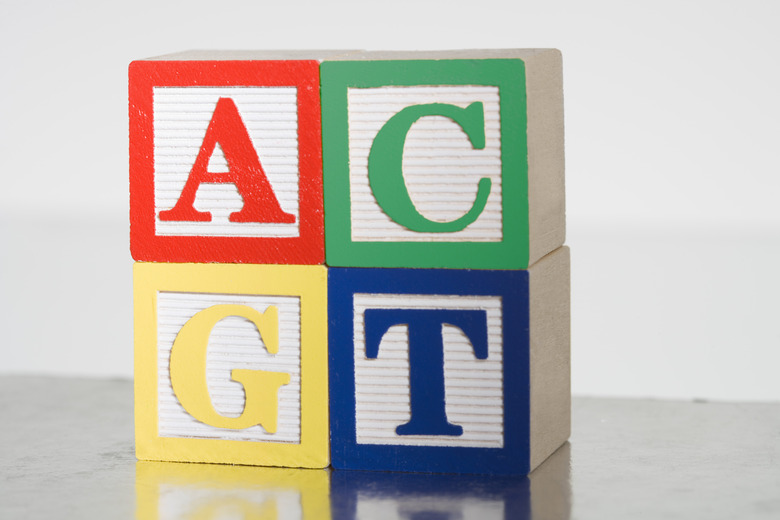Does DNA Tell The Cells What Proteins To Make?
Deoxyribonucleic acid, most commonly known as DNA, is what's used as cellular life's genetic material. It's DNA that holds all of our genes that make us who we are. It's the proteins that are made from these genes that allow our cells to function, that give us our hair color, that help us grow and develop, fight off infections, etc.
But does DNA really tell our cells what proteins to make? The answer is **yes and no**.
While DNA does encode the information needed to make proteins, the DNA itself is only the blueprint for proteins. In order for the information encoded in DNA to become a protein, it needs to first be transcribed into mRNA and then translated at ribosomes in order to create the protein.
It's this process that spawned what's known as the central dogma of genetics: DNA ➝ RNA ➝ Protein
Deoxyribonucleic Acid (DNA) Is the Blueprint
Deoxyribonucleic Acid (DNA) Is the Blueprint
DNA is the genetic material used by all cellular life and is made up of subunits called nucleotides.
These subunits are each made up of three parts:
1. Phosphate group 2. Deoxyribose sugar 3. Nitrogenous base
There are four distinct nitrogenous bases: adenine (A), thymine (T), guanine (C) and cytosine (C). Adenine always pairs with thymine and guanine always pairs with cytosine.
DNA is a type of nucleic acid that's made up of these individual nucleotide subunits that come together to form two strands. The phosphates and sugars form the backbone of the DNA strands. The two strands are held together by hydrogen bonds that form between the nitrogenous bases.
It's these nitrogenous bases that hold the code for proteins. It's the specific order of the nitrogenous bases, also known as the DNA sequence, which is like a foreign language that can be translated into a protein sequence. Each length of DNA that makes up the "instructions" for a protein is called a **gene**.
Transcription into mRNA
Transcription into mRNA
So where does protein production begin? Technically, it starts with transcription.
Transcription occurs when an enzyme called RNA polymerase "reads" a DNA sequence and turns it into a complementary corresponding strand of mRNA. mRNA stands for "messenger RNA" because it serves as the messenger, or the middle man, between the DNA code and the eventual protein.
The mRNA strand is complementary to the DNA strand it copies, except that instead of thymine, RNA uses uracil (U) to complement adenine. Once this strand is copied, it's known as the pre-mRNA strand.
Before the mRNA leaves the nucleus, non-coding sequences called "introns" are taken out of the sequence. What's left, known as exons, are then combined together to form the final mRNA sequence.
This mRNA then leaves the nucleus and finds a ribosome, which is the site of protein synthesis. In prokaryotic cells, there is no nucleus. Transcription of mRNA occurs in the cytoplasm and occurs simultaneously.
mRNA Is Then Translated into Proteins at Ribosomes
mRNA Is Then Translated into Proteins at Ribosomes
Once the mRNA transcript is made, it makes its way to a ribosome. Ribosomes are known as the protein factory of the cell since its here where the protein product is actually synthesized.
mRNA is made up of triplets of bases, which are called "codons." Each codon corresponds to one amino acid in an amino acid chain (aka a protein). This is where "translation" of the mRNA code occurs via transfer RNA (tRNA).
As the mRNA is fed through the ribosome, each codon matches up with an anticodon (the complementary sequence to the codon) on a tRNA molecule. Each tRNA molecule carries a specific amino acid that corresponds to each codon. For example, AUG is a codon that corresponds to the amino acid methionine.
When the codon on the mRNA matches with the anticodon on a tRNA, that amino acid is added to the growing amino acid chain. Once the amino acid is added to the chain, the tRNA exits the ribosome to make room for the next mRNA and tRNA match.
This continues and the amino acid chain grows until the entire mRNA transcript has been translated and the protein is synthesized.
Cite This Article
MLA
Walsh, Elliot. "Does DNA Tell The Cells What Proteins To Make?" sciencing.com, https://www.sciencing.com/dna-tell-cells-proteins-make-3064/. 17 July 2019.
APA
Walsh, Elliot. (2019, July 17). Does DNA Tell The Cells What Proteins To Make?. sciencing.com. Retrieved from https://www.sciencing.com/dna-tell-cells-proteins-make-3064/
Chicago
Walsh, Elliot. Does DNA Tell The Cells What Proteins To Make? last modified August 30, 2022. https://www.sciencing.com/dna-tell-cells-proteins-make-3064/
